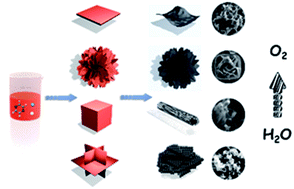Morphology regulation of metal–organic framework-derived nanostructures for efficient oxygen evolution electrocatalysis†
Abstract
Understanding the relationship between the morphology of the metal–organic framework-derived nanostructures and their performance as catalysts in the oxygen evolution reaction (OER) is very important and highly desirable, because such a study would provide a new insight into the systematic regulation of the catalyst morphology for performance enhancement in electrocatalysis and photocatalysis. Here, a series of accurately morphology-regulated electrocatalysts (including nanosheets, nanoflowers, nanotubes and aggregations) derived from Hofmann-type metal–organic frameworks (MOFs) are reported for efficient OER. Among all the nanostructures, FeNi nanosheets show the best OER catalytic performance in alkaline media, achieving a low overpotential of 248 mV at 10 mA cm−2, an ultra-small Tafel slope of 31.2 mV dec−1 and a satisfactory stability, greatly outperforming the commercial RuO2 catalyst. The reason is that FeNi nanosheets possess optimized conductivity, oxygen vacancies and N-related active sites. Our research also demonstrates that electron transfer can be achieved through the precise control of the morphology of precursor MOFs.



 Please wait while we load your content...
Please wait while we load your content...